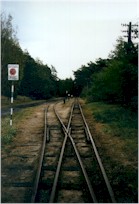
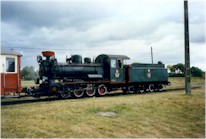
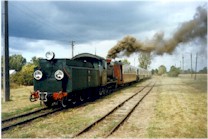
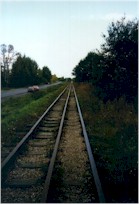
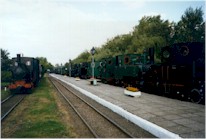
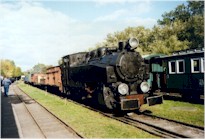
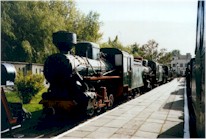
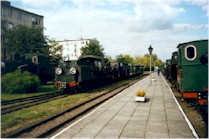
The Powiatowa Kolej Sochaczewska (Sochaczew District Railway) was built in 1921 from Sochaczew (where there was a connection with the standard gauge Warszawa – Lowicz line) to Tulowice; it officially opened in 1922. In 1923 it was extended to Piaski Krolewskie (26km from Sochaczew) where there was a connection with a 600mm gauge forestry railway which had been built by the Germans during the First World War. A 6km branch was also built from Tulowice to a station on the banks of the river Wisla. Although the station was called Wyszogrod that town is actually on the other side of the river, connected by what is believed to be the longest timber bridge in Europe – in 1997 it was in poor condition and a new bridge was under construction a little way downstream.
After the Second World War the line was taken over by PKP. In 1968 a 2.4km section on the northern fringe of Sochaczew became mixed gauge when a standard gauge line was added to reach an industrial plant. The 15.35 departure from Sochaczew to Wyszogrod on 30 November 1984 was the last timetabled train. On the following day the line was taken over by the Railway Museum (of Warszawa) and opened as Muzeum Kolej Waskotorowej on 6 September 1986.
As part of the museum’s activities trains are run from Sochaczew to Wilcze Tulowskie (17km). The line beyond that point to Piaski Krolewskie has been abandoned, as has the line to Wyszogrod (although at least some of the track is still in-situ). The 2001 summer timetable showed one train each way on Saturdays June to September. Motive power for the trains consisted of PKS3, Px29-1704 and Px48-1755, although only the Px29 appears to be serviceable now. PKS3 was built for the line in 1925 by Orenstein & Koppel. The 90hp 0-8-0T worked throughout the line’s independent days, and following the PKP take-over was re-numbered Tx2-1246. In 1961 it became Tx4-1315 and in 1970 was transferred to Piotrkow Trybunalski, where it was used as a stationary boiler until going to the Warszawa Railway Museum in 1973. It returned to Sochaczew in 1986. The Px29 is another interesting locomotive, being Poland’s only operational example of the class, originally designated Wp29, which was later developed to become the Px48. Lyd1 diesels are also available for traffic.
The museum itself is located at the former Sochaczew Wask. station. There is a range of locomotives and rolling stock displayed, from a variety of sites, including some 785mm gauge examples from Upper Silesia. The greatest concern is that all these items are outdoors all year round, and will inevitably deteriorate in time, although they are well looked after and regularly painted. The ‘reserve’ collection, which is kept hidden away behind high fences, contains many more items, some in very poor condition.
The railway’s history is described in Bogdan Pokropinski’s book “Powiatowa Kolej Sochaczewska” published by Muszeum Kolejnictwa w Warszawie. Copies were on sale at Sochaczew in October 1997.
Special trains can be run to order. The museum is open from 10.00 to 16.00 except Mondays – it may close earlier on some days. Train services are included in the PKP timetable.
The contact address is:
Muzeum Kolei Waskotorowej, Towarowa 7, PL-96-500 Sochaczew, tel. (0-494) 224-05 wew. 341.
Some basic information which may be of use to those planning a visit:
http://www.kolej.pl/~pablo/pl/info_Sochaczew.html
 |
 |
 |
| September 1997 | September 1997 | September 1997 |
| The present terminus at Wilcze Tulowakie | Px29-1704 at Tulowice | Px29-1704 about to depart from Tulowice |
 |
 |
 |
| September 1997 | September 1997 | September 1997 |
| Dual gauge section near Chodakow | Some of the Steam loco at the museum | Loco and wagons from Upper Silesia (785mmgauge) |
 |
 |
|
| September 1997 | September 1997 | |
| Kp4 at the Museum | Px29 shunting some of the displayed stock |
|
|
||
Return to Narrow Gauge Railways of Poland |
© Andrew
Goodwin, Stephen Goodwin & Dave Meller
1996-2003
|
|